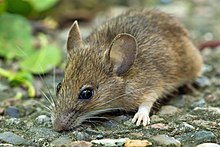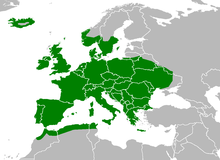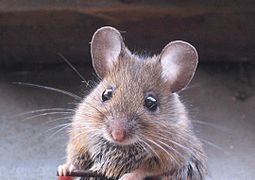Wood mouse
| Wood mouse | |
|---|---|

| |
| Scientific classification | |
| Domain: | Eukaryota |
| Kingdom: | Animalia |
| Phylum: | Chordata |
| Class: | Mammalia |
| Order: | Rodentia |
| Family: | Muridae |
| Genus: | Apodemus |
| Species: | A. sylvaticus
|
| Binomial name | |
| Apodemus sylvaticus | |

| |
| Apodemus sylvaticus range (in green) | |
| Synonyms | |
|
Mus sylvaticus Linnaeus, 1758 | |
The wood mouse (Apodemus sylvaticus) is a

Habitat and distribution

Wood mice inhabit forests, grasslands, and cultivated fields, tending to seek out more wooded areas in winter.
Diet
Wood mice are primarily seed eaters,[7] particularly seeds of trees such as oak, beech, ash, lime, hawthorn, and sycamore. If seeds are plentiful on the ground, they carry them back to their nests/burrows for storage.[8] They may eat small invertebrates such as snails and insects, particularly in late spring and early summer when seeds are least available. Later in the season they will eat berries, fruits, fungi and roots. In winter, they may prey on hibernating bats, but this is still debatable.[9]
Behaviour
Wood mice are mainly active during the dark, probably having evolved so to avoid predation, employing several anti-predatory strategies, though breeding females may be more active in daylight in order to collect sufficient food.
Predation
Predators of wood mice include foxes, snakes, weasels, birds of prey including owls, and also cats and dogs.[14]
Reproduction
The wood mouse has a
One interesting observation about the species, in particular the males, is the morphology of the
The gestation period of wood mice is of 25–26 days and each female produces on average four young per year. The offspring become independent after about three weeks and become sexually active after two months.
Gallery
-
portrait
-
cherry stone hoard
-
Wood mouse in an attic
References
- ^ . Retrieved 23 April 2021.
- .
- ISBN 978-0-444-51877-4.
- PMID 15695684.
- JSTOR 1381994. Retrieved 2 November 2018.
- ^ Encyclopædia Britannica. 2008. Wood mouse
- hdl:10261/54625.
- ^ Phil Gates (6 September 2018). "Country diary: a close encounter with a wood mouse". The Guardian. Retrieved 2 November 2018.
- hdl:2066/163408.
- ISBN 9783642182648. Retrieved 2 November 2018.
- PMID 12697070.
- ^ "Mice make their own signposts". Nature. 2 May 2003. Retrieved 4 February 2020.
- ^ Goaman, K., Amery, H. (1983). Mysteries & Marvels of the Animal World, p. 15.
- ^ "The Mammal Society" (PDF). Retrieved 2 November 2018.
- S2CID 4413444.
Further reading
- Fairley, J.S. 1975. An Irish Beast Book. Blackstaff Press Limited. ISBN 0-85640-090-4
External links
- Apodemus sylvaticus in the Smithsonian Museum of Natural History MSW Scientific Names
- Apodemus sylvaticus in the Catalogue of Life: 2007 Annual Checklist
- Apodemus sylvaticus in Fauna Europaea
- Apodemus sylvaticus in the Animal Diversity Web
- The wood mouse, an excellent article in French
- The market effect in the wood mouse, an excellent abstract of research done on grooming and reproduction in wood mouse



